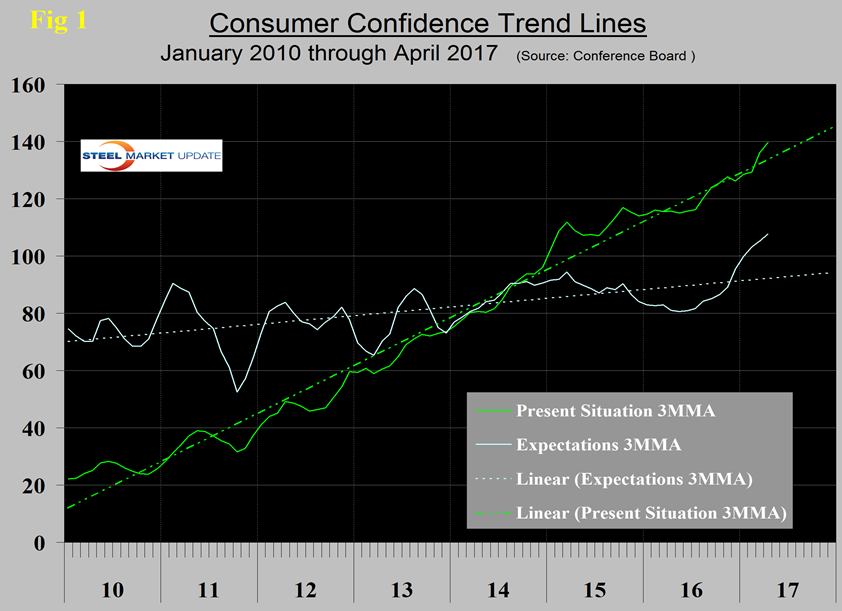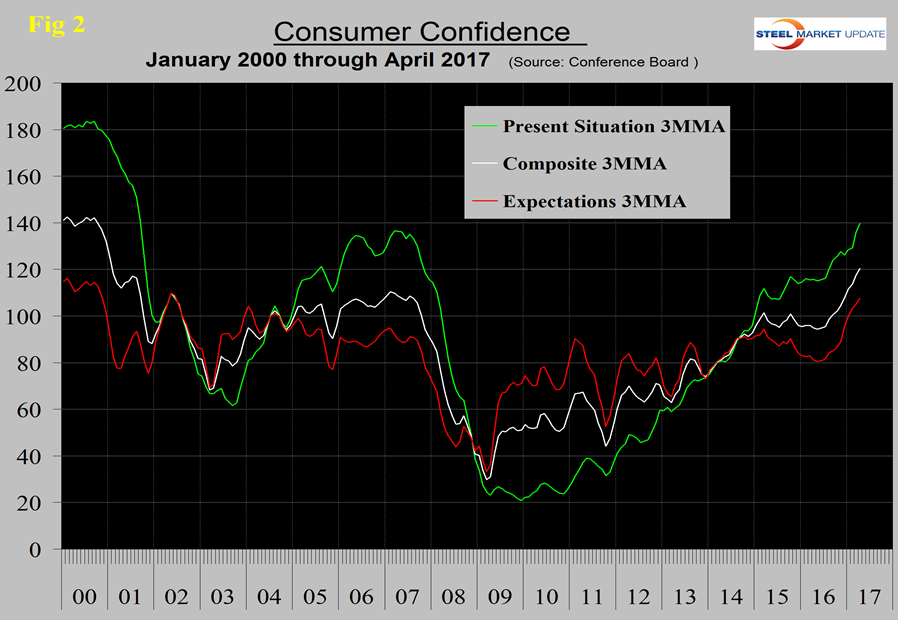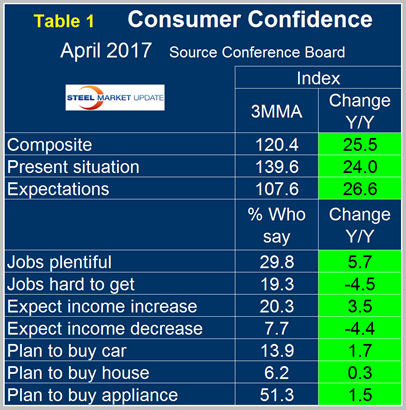Economy

Consumer Confidence in April 2017
Written by Peter Wright
May 3, 2017
The source of this data is the Conference Board with analysis by Steel Market Update. Please see the end of this piece for an explanation of the indicator.
![]() Consumer Confidence decreased 4.6 points in April, falling to 120.3 but this is still the second highest reading since December 2000. The three month moving average (3MMA was the highest since January 2001. Consumers are feeling better about the current economic environment and their prospects for the coming months. Confidence is up 25.6 points from a year earlier. The low point for consumer confidence last year was May with a value of 92.4. Consumer confidence is the driver of consumer spending which is the largest component of GDP and which ultimately drives a large portion of steel consumption.
Consumer Confidence decreased 4.6 points in April, falling to 120.3 but this is still the second highest reading since December 2000. The three month moving average (3MMA was the highest since January 2001. Consumers are feeling better about the current economic environment and their prospects for the coming months. Confidence is up 25.6 points from a year earlier. The low point for consumer confidence last year was May with a value of 92.4. Consumer confidence is the driver of consumer spending which is the largest component of GDP and which ultimately drives a large portion of steel consumption.
Included at the end of this write up is the official news release from the Conference Board.
In April the 3MMA of the composite increased from 117.5 to 120.4 (Figure 1).
We prefer to smooth the data with a moving average because of monthly volatility which in the case of consumer confidence has been quite extreme since the beginning of last year. The composite index is made up of two sub-indexes. These are the consumer’s view of the present situation and his/her expectations for the future. Both are now above their eight year trend line. Expectations have surged well past their trend line in the last four months (Figure 1). The historical pattern of the 3MMA of the composite, the view of the present situation and expectations are shown in Figure 2.
The 3MMA of the composite made no progress from early 2015 through mid 2016 as improvements in the consumer’s view of the present situation were negated y a decline in expectations. Since mid 2016 both components of the index have surged. The Comparing April 2017 with April 2016 (y/y) the 3MMA of the composite was up by 25.5, the present situation was up by 24.0 and expectations were up by 26.6 (Table 1).
All sub indices in Table 1 are now green .The consumer confidence report includes encouraging data on job availability and wage expectations. It reports on the proportion of people who find that jobs are hard to get and those who believe jobs are plentiful and it measures those who expect a wage increase or a decrease. Since August 2011 both of the job availability components have steadily improved. Expectations for wage increases have not been as consistent but in this report the differential between those expecting an increase and those expecting a decrease was the best since before the recession. Plans to buy a house were negative in January through March but became positive in April. Plans to buy a car have been positive y/y since September.
SMU Comment: Consumer confidence continues to be on an excellent track particularly for expectations. The employment sub indexes are good which will drive personal consumption, the largest component of GDP. This is turn will have a positive effect on steel consumption.
The official news release from the Conference Board reads as follows:
The Conference Board Consumer Confidence Index Declined in April
The Conference Board Consumer Confidence Index®, which had increased in March, declined in April. The Index now stands at 120.3 (1985=100), down from 124.9 in March. The Present Situation Index decreased from 143.9 to 140.6 and the Expectations Index declined from 112.3 last month to 106.7.
The monthly Consumer Confidence Survey®, based on a probability-design random sample, is conducted for The Conference Board by Nielsen, a leading global provider of information and analytics around what consumers buy and watch. The cutoff date for the preliminary results was April 13.
“Consumer confidence declined in April after increasing sharply over the past two months, but still remains at strong levels,” said Lynn Franco, Director of Economic Indicators at The Conference Board. “Consumers assessed current business conditions and, to a lesser extent, the labor market less favorably than in March. Looking ahead, consumers were somewhat less optimistic about the short-term outlook for business conditions, employment and income prospects. Despite April’s decline, consumers remain confident that the economy will continue to expand in the months ahead.”
Consumers’ assessment of current conditions eased in April. Those saying business conditions are “good” declined from 32.4 percent to 30.2 percent, while those saying business conditions are “bad” increased slightly, from 13.1 percent to 13.8 percent. Consumers’ assessment of the labor market was moderately less favorable. Those stating jobs are “plentiful” declined from 31.8 percent to 30.8 percent, while those claiming jobs are “hard to get” was virtually unchanged at 19.1 percent.
Consumers were less optimistic about the short-term outlook in April. The percentage of consumers expecting business conditions to improve over the next six months decreased from 26.9 percent to 24.8 percent, while those expecting business conditions to worsen rose from 8.5 percent to 10.9 percent.
Consumers’ outlook for the labor market was also less upbeat. The proportion expecting more jobs in the months ahead declined from 23.8 percent to 23.0 percent, while those anticipating fewer jobs increased from 12.7 percent to 13.1 percent. The percentage of consumers expecting their incomes to increase declined from 22.5 percent to 19.3 percent, while the proportion expecting a decrease held steady at 7.5 percent.
Source: April 2017 Consumer Confidence Survey
About The Conference Board
The Conference Board is a global, independent business membership and research association working in the public interest. Our mission is unique: To provide the world’s leading organizations with the practical knowledge they need to improve their performance and better serve society. The monthly Consumer Confidence Survey, based on a probability-design random sample, is conducted for The Conference Board by Nielsen, a leading global provider of information and analytics around what consumers buy and watch. The index is based on 1985 = 100. The composite value of consumer confidence combines the view of the present situation and of expectations for the next six months. The Conference Board is a non-advocacy, not-for-profit entity holding 501 (c) (3) tax-exempt status in the United States. www.conference-board.org.

Peter Wright
Read more from Peter WrightLatest in Economy

Steel groups welcome passage of budget bill
Steel trade groups praised the passage of the Big Beautiful Bill (BBB) in Congress on Thursday.

Industry groups praise Senate for passing tax and budget bill
The Steel Manufacturers Association and the American Iron and Steel Institute applauded the tax provisions included in the Senate's tax and budget reconciliation bill.

Chicago PMI dips 0.1 points in June
The Chicago Purchasing Managers Index (PMI) slipped 0.1 points to 40.4 points, in June.

Multi-family pullback drives housing starts to 5-year low in May
US housing starts tumbled in May to a five-year low, according to figures recently released by the US Census Bureau.

Architecture firms still struggling, ABI data shows
Architecture firms reported a modest improvement in billings through May, yet business conditions remained soft, according to the latest Architecture Billings Index (ABI) release from the American Institute of Architects (AIA) and Deltek.



